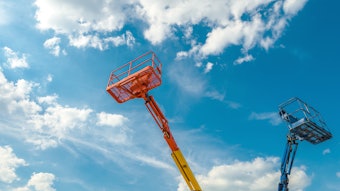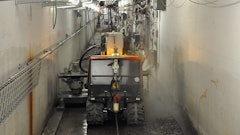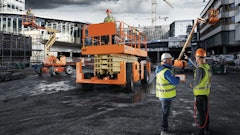
Before purchasing your next telehandler, closely examine how you will use it. Given the array of attachments available - including augers, buckets, work platforms, blades, tree shears, truss booms, etc. - it may be possible to increase utilization and reduce the need for multiple pieces of equipment on the site.
There are also more alternatives for telehandlers themselves. In addition to traditional lift-and-carry models, you have a choice of tool carrier, agricultural, ground-engaging and compact versions.
"That's what separates the manufacturers," says Steve Kirst, telehandler product manager, Gehl Company. "Some manufacturers are good at one thing. They are really focused. Others are more diversified and are very good at different categories. But try to put a pick-and-place machine into an agricultural application and you will fail. They are totally different machines when it comes to how they are engineered and how they are manufactured."
Specialized or accessorized?
Every telehandler type has its own unique performance characteristics. For example, Manitou offers a multipurpose telehandler for niche applications. While primarily used by ag customers, it does cross over into construction and landscaping.
"The machines are more full featured," says Ryan Ford, product specialist - telehandlers, Manitou. "They all come with fully enclosed cabs. Defrosters are standard on all of them, and the majority come with air conditioners."
They also offer higher horsepower ratings than most standard construction telehandlers. "These machines are running about 40 gpm at 3,900 psi, so they are capable of multi-tasking simultaneous movements with no loss of speed," Ford adds.
A masonry contractor recently purchased one of these units. "They were using it to drill post holes because they were putting fencing around a huge subdivision community. The unit had more than enough hydraulic performance to sink those holes in the ground," Ford states. "It can handle 8,000 lbs. of materials and place them at 30 ft. in the air."
But you do need the right application to justify this premium piece of equipment. "You need that hydraulic performance, or you need the capability of doing a continuous run," Ford notes.
For other applications, careful selection of options can help you to earn a greater return on your investment. "A residential home builder who generally uses his telehandler for roughing the house, then rents an aerial work platform for the soffit and facia work, can now use the Gehl Personnel Work Platform (PWP) System on his telehandler," Kirst points out. This eliminates the need to bring in an aerial work platform.
"A contractor in a northern climate typically experiences a slow down in the winter time," Kirst continues. "If he has the proper type of telehandler, he can now use it with a large bucket for snow removal, or landscaping, thereby increasing the utilization time of his machine, and providing additional income."
When assessing telehandler configurations or options, you need to be realistic about how the machine will be used. "Study your usage wisely," says Ford.
For example, you may find you don't actually need a full-size unit. "If you only need to lift 7,000 lbs. and you never get above 25 ft., we have a machine that will suit those needs," says Ford. It is less expensive and may fill your needs better than an alternative telehandler.
Deluxe or basic?
With all of the machine variations available, a little research is necessary. For instance, some companies offer both "deluxe" and "plain Jane" models, while others offer a long list of options to customize a given model for your unique needs.
"Gehl has two distinctly different models: the RS Series is the 'plain Jane' machine, whereas the DL Series is the feature-filled model," says Kirst. Differences include high and low boom configurations, more horsepower, greater capacity with longer boom lengths, joystick options, quick-attach options, a more deluxe cab, an air conditioner option and generally higher quality/higher technology componentry.
The choice really depends on what you are trying to accomplish. A contractor seeking a multi-tasking machine will prefer the DL Series, says Kirst. "A steel erector would probably just need a single-dimension machine that lifts things up and places them high in the air, so the RS Series would be fine for him."
JLG has another approach, in which its brands are differentiated by features. The company offers four distinct brands: JLG, Lull, Gradall and Sky Trak.
"Each of the brands has its own unique position in the market," says Brian Boeckman, product parent, North American Telehandlers, JLG Industries, Inc. They each offer a unique value proposition that allows the customer to choose which best meets jobsite demands. For instance, the Gradall features rear-pivot steer; the Lull has a traversing carriage; the JLG is more of a 'deluxe' unit; and the Sky Trak is the basic machine.
Compact units prove versatile
Compact telehandlers are gaining acceptance on many jobsites. "There has been a lot of growth in the smaller, under 6,000-lb. range machines in the U.S. and Canada," says Mark Eckert, Ingersoll Rand. "We have some tool carrier machines that are smaller with a shorter wheelbase and a two-section boom in 5,000- and 6,000-lb. capacities."
Kirst also notes a market shift. "In the past, the trend was to go bigger and higher." It has now shifted to smaller models. "Similar to how the mini-excavator and skid-steer loader have been replacing the backhoe-loader, smaller, lower cost telehandlers - which are easier to transport and more nimble on busy, confined jobsites - are becoming more convenient and economical," he states.
Luke Webber, telehandler product manager at Genie, adds, "On any jobsite, there is need for a compact model that performs most of the material movement, from unloading trucks to picking and placing materials. It offers the versatility of a tool carrier, allowing contractors to use it in place of the more traditional tool carrier machines, such as skid-steer loaders."
Although they offer lower lift heights, compact telehandlers fit in areas a full-size machine can't access.
Manitou actually offers a three-wheel-drive telehandler that is the size of a skid steer and provides a 13-ft. lift height with a 3,000-lb. capacity. "A step up from that, you are jumping into the more full-featured, traditional-type telehandler with four-wheel drive, a 5,000-lb. capacity and a 16-ft. lift height," says Ford. "It can do 80% of the work on that jobsite. The only thing it can't do is the high lift."
Versatility is really the compact's strength. "You can use the machine for many different applications on the same jobsite," says Eckert. "When the foundation and basement walls are complete, you can use the telehandler to set the center beam. After that, you can use it while framing the building. With a truss boom, it can be used to set the roof trusses. And later, it can deliver material for completing the roof."
Comfort equals productivity
Enclosed cabs, air conditioning, heat, suspensions seats, tilt steering columns and various joystick options enhance operator comfort. Justifying these options really boils down to your business model.
"The 'basic' telehandler is the most popular machine configuration," says Webber. "Many of our customers' business models are measured on ROI, so the lower the acquisition cost of the machine, the better it looks on paper. However, many of our available options are intended to help improve customers' ROI by either minimizing repair costs and downtime or enhancing productivity.
"It's somewhat rare if we build a telehandler that doesn't have a single option on the machine," he continues. "If contractors order through our dealer network, they typically are measured more on productivity, and therefore tend to order, or rent, telehandlers with options. Our rental customers are measured more on ROI, and therefore look for a simpler telehandler configuration."
More people are beginning to justify comfort options. Eckert reports Ingersoll Rand currently fits enclosed cabs on 20% to 25% of its telehandlers. "If you go back enough years, you couldn't even find an enclosed cab," he states.
As utilization increases, comfort becomes more of an issue. "When you start talking about things that are geared toward operator comfort, like heat and air conditioning, that certainly ties into productivity," says Boeckman. "A comfortable operator is a more productive one."
Beyond tradition
The growing use of attachments is transforming the telehandler market. "The pick-and-place application is a mature market," Kirst notes. "The opportunities are getting away from pick and place and going toward the tool handler concept."
"Telehandlers are tending to become more of a multi-use machine," Boeckman agrees. "Once you move beyond a standard fork and carriage - when you start talking about lifting hooks and truss booms - the number of applications for a telehandler greatly increases."
Because the basic machines have not really changed a lot, says Eckert, what really differentiates one machine from another are options and attachments. This is changing how customers spec machines.
"We are seeing more requests for attachments and options," says Ford. "We have requests for closed cabs, air conditioning and additional attachments. Utilization is picking up and driving some of those things."






























